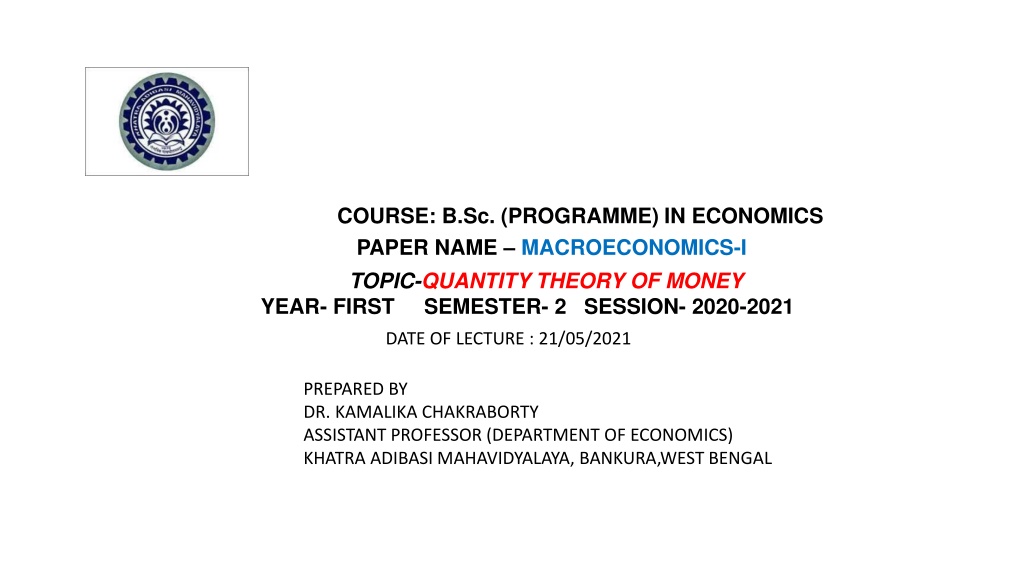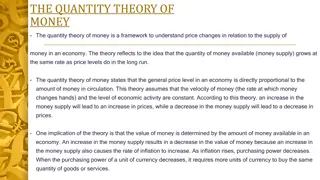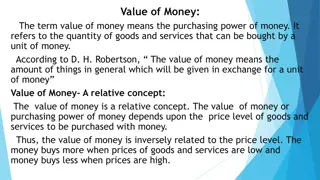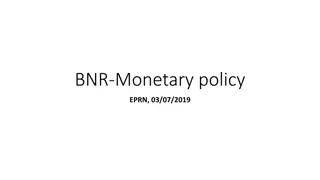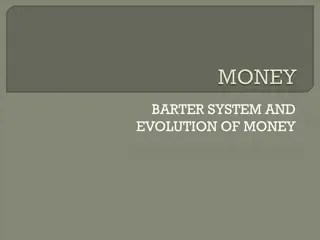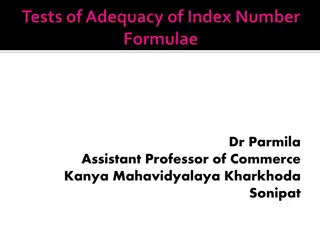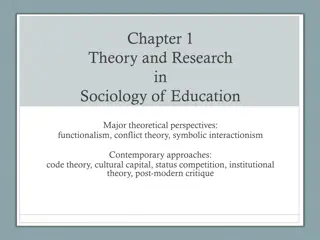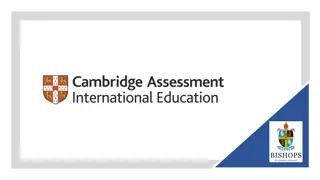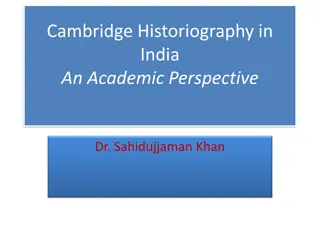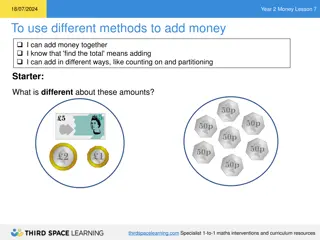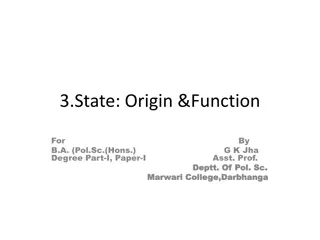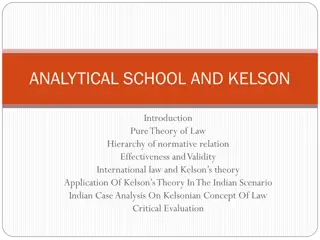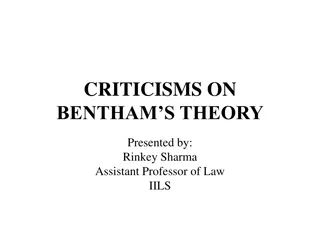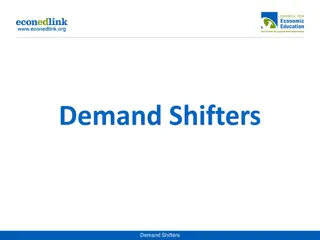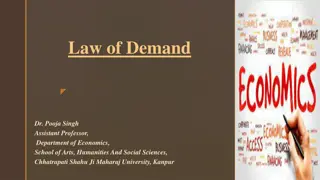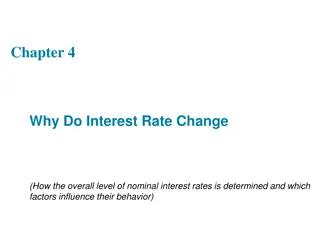Understanding the Quantity Theory of Money: Fisher vs. Cambridge Perspectives
The Quantity Theory of Money explains the relationship between money supply and the general price level in an economy. Fisher's Equation of Exchange and the Cambridge Equation offer different perspectives on this theory, focusing on money supply vs. demand for money, different definitions of money, and implications for price levels. Fisher emphasizes money supply, while Cambridge stresses the demand for money as a store of value. Both perspectives provide valuable insights into the dynamics of money in an economy.
Download Presentation

Please find below an Image/Link to download the presentation.
The content on the website is provided AS IS for your information and personal use only. It may not be sold, licensed, or shared on other websites without obtaining consent from the author. Download presentation by click this link. If you encounter any issues during the download, it is possible that the publisher has removed the file from their server.
E N D
Presentation Transcript
COURSE: B.Sc. (PROGRAMME) IN ECONOMICS PAPER NAME MACROECONOMICS-I TOPIC-QUANTITY THEORY OF MONEY YEAR- FIRST SEMESTER- 2 SESSION- 2020-2021 DATE OF LECTURE : 21/05/2021 PREPARED BY DR. KAMALIKA CHAKRABORTY ASSISTANT PROFESSOR (DEPARTMENT OF ECONOMICS) KHATRA ADIBASI MAHAVIDYALAYA, BANKURA,WEST BENGAL
INTRODUCTION According to the quantity theory of money, the general price level of goods and services is proportional to the money supply in an economy. According to the quantity theory of money, if the amount of money in an economy doubles, all else equal, price levels will also double. FISHER S EQUATION OF EXCHANGE According to Fisher, Other things remaining unchanged, as the quantity of money in circulation increases, the price level also increases in direct proportion and the value of money decreases and vice versa . Fisher s equation of exchange is given by : MV = PT or P = MV/T The supply of money consists of the quantity of money in existence (M) multiplied by the number of times this money changes hands, i.e., the velocity of money (V). The demand for money is equal to the total market value of all goods and services transacted. It is obtained by multiplying total number of transactions(T) by average price level (P)
FISHERS EQUATION OF EXCHANGE (CONTD.) Fisher s equation of exchange represents equality between the supply of money or the total value of money expenditures in all transactions and the demand for money or the total value of all items transacted. Irving Fisher further extended the equation of exchange so as to include demand (bank) deposits (M ) and their velocity, (V ) in the total supply of money. Thus, the equation of exchange becomes: Income version of Fisher s theory is given by MV=PY Where Y is real income and V is now the income velocity of circulation. Here V shows the number of times a unit of money circulates as income.
CAMBRIDGE EQUATION OF EXCHANGE The Cambridge economists like Alfred Marshall and A. C. Pigou presented an alternative to Fisher s version of Quantity Theory. Formally, the Cambridge equation is identical with the income version of Fisher s equation: M = kPY, where k = 1/V in the Fisher s equation. k and Y are determined independently of the money supply. With k constant given by the transaction demand for money and Y constant because of full employment, increase or decrease in money supply leads to a proportional increase and decrease in price level. This conclusion holds for Fisherian version also. Note that Cambridge k and Fisherian V are reciprocals of one another, that is, 1/k is the same as V in Fisher s equation.
Important dissimilarities between the two approaches : 1. Relative Importance on Supply and Demand for Money: Fisher s approach stresses the supply of money, whereas, the Cambridge approach lays more emphasis on the demand for money to hold cash. 2. Definition of Money: The two approaches use different definitions of money. The Fisher s version emphasises the medium of exchange function of money, whereas the Cambridge approach stresses on the store of value function of money. 3. Flow and Stock Concepts: The Fisherian approach regards money as a flow concept; money is considered in terms of flow of money expenditures. The Cambridge version regards money as a stock concept; money supply refers to a given stock at a particular point of time. 4. Transaction and Income Velocities: Fisherian approach emphasises the importance of the transaction velocity of circulation (i.e., V). The Cambridge Version, on the contrary, lays stress on the income velocity of the part of income which is held in the cash balance (i.e., K).
5. Nature of P: In both approaches, the price level (P) is not used identically. In Fisher s version, P is the average price level of all goods. On the contrary, in Cambridge version. P refers to the price of consumer goods. 6. Factors Affecting V and K: Fisher is concerned about the institutional and technological factors governing how fast individuals can spend their money (i.e., V). The Cambridge School, on the other hand, is concerned about the economic factors determining what portion of their wealth the public desires to hold in the form of money (i.e., K). 7. Relationship between M and P: The Fisherian approach maintains that any change in the money supply produces proportional changes in the price level. This is because Fisher believes that both velocity and real income are in the long run independent of each other and of supply of money. In the Cambridge approach, the price level may change by more or less than the money supply; it depends upon what happens to the stock of non-monetary assets and their expected yields on which the Cambridge economists believed the desired cash balances depend. 8. Different Approaches to Monetary Theory: Both Fisher and Cambridge School led to the development of two different approaches to the monetary theory. Fisher s approach has given rise to an inventory theory of money holding largely for transactions purposes. On the other hand, the Cambridge approach has been developed into portfolio, or capital theoretic approach to monetary demand.
